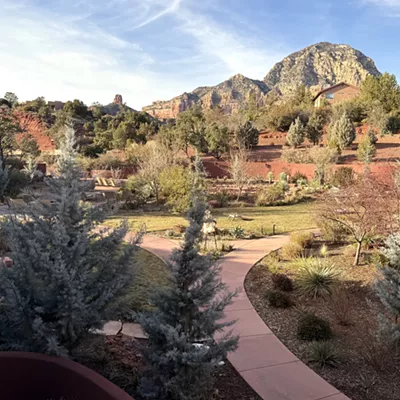Not so long ago, this isolated spot was like most of the surrounding Sonoita Valley countryside about an hour's drive southeast of Tucson, covered with tall grasses and cactus shaded by mesquite, cottonwood and ash trees.
Now the hillside, which leads into an area known as The Narrows, is a chewed-up mess of boulders, concrete posts and metal stakes.
The environmental carnage is the result of a battle over an old dirt road that rolls down the hill and then leads drivers back and forth across Cienega Creek, a rare desert stream that's home to endangered species.
Federal wildlife officials want the road closed to prevent any damage to the creek, but drug smugglers and illegal migrants are determined to keep it open, because it provides a clear shot to Interstate 10 and the rest of the promised land.
Hare, a conservation biologist with the Sky Island Alliance, first assembled a crew of volunteers last March to try to close the road down. The BLM initially tried to block it off last year, but the smugglers skirted the boulders and cut down the fence that had been placed in their way.
Hare's team spent a day planting bushes, dragging dead branches across the road, mending the fence and strategically placing big rocks to discourage vehicles.
It wasn't nearly enough. Within a week, the smugglers had cleared the rocks, cut through the fence and re-opened the road.
Hare and his crew returned in April, and spent an entire Saturday pounding steel stakes into the ground and moving more rocks to block access to the road. When they returned to do more work on Sunday morning, they found that someone had driven around the side of the new barrier overnight, creating a new road down the side of a small cliff.
"We had quite the enterprising smugglers on our hands," Hare says.
The group met the challenge, going right to work to block the latest cut with a bundle of strategically placed steel posts.
Within three weeks, Hare got word that the smugglers had broken through once more. He assembled his volunteers and returned to pound more stakes, move more rocks and re-vegetate the area again.
"Within a week," Hare says, "it got busted through again."
It was time to bring in heavy machinery. In September, after consulting with various federal agencies, Hare and his crew rented a front loader and moved boulders that weighed more than a ton to block the road. They sank posts into concrete. They again put plants and debris along the road.
The new roadblock held--for a couple of weeks. Now the drivers have gone around the other side of the boulders and the posts, creating yet another steep descent down the road.
"They found another way," says Hare, as he notices a twisted tie-rod and an abandoned jack in the dirt. "Well, at least we slowed them down some."
The battle over the road is just one small example of how illegal immigration and smuggling is tearing apart the landscape of Southern Arizona.
Karen Simms, an ecosystems planning team leader with the Bureau of Land Management, explains that officials wanted to close the road to decrease the possibility of damage to Cienega Creek, thus protecting the endangered Gila topminnow and other critters that depend on the stream. "It's been a big challenge," she says.
Simms says the 96,000 acres of Las Cienegas National Conservation Area and the adjoining Sonoita Valley Acquisition Planning District are crisscrossed by dirt roads, jeep trails and horse paths that lead from the border to the freedom of I-10 or I-19. It's a snapshot of the widespread problem that stretches across public and private land near Mexico.
"From their perspective, smugglers need to get this stuff to metropolitan areas or wherever, so we're just in the path of where they need to go," says Simms.
And when smugglers and migrants can't find a road, they don't hesitate to make a new one--a problem that's becoming particularly acute in the Ironwood Forest National Monument, according to Lorraine Buck, a spokeswoman for the BLM's Tucson Field Office. Illegal migrants who cross the Tohono O'odham reservation dump out onto the monument and then into Marana or onto I-10.
"It causes a great deal of environmental degradation," Buck says. "They're not choosy about what they run over."
These problems have been festering for years. In response to a request by Congressman Jim Kolbe, several federal agencies--including the Environmental Protection Agency, the Department of the Interior and the Border Patrol--delivered a report to Congress that outlined the impacts of illegal immigration in the 14,000 square miles of Southern Arizona closest to the Mexican border.
The report noted that illegal immigrants and smugglers were creating thousands of new trails, starting fires, abandoning vehicles, dumping trash and vandalizing property.
"Gates are rammed, security locks are cut, signs are driven over and heavy damage or destruction of water developments and other improvements by undocumented aliens traveling through federal lands and seeking drinking water in remote locations occur regularly," the report notes. "Tons of trash and high concentration of human waste are left behind by undocumented aliens. This impacts wildlife, vegetation and water quality in the uplands, in washes and along rivers and streams."
The report said mitigating the impact would cost $23 million and require 90 new full-time employees in the first year. The estimated five-year cost was $62.9 million.
So far, only a tiny fraction of that funding has materialized: In fiscal year 2003, Kolbe earmarked $1 million in the federal budget to mitigate environmental impacts, which was eventually trimmed to $695,000. A total of $410,000 reached the Tucson Field Office, according to BLM officials.
In the fiscal '04 year that ended in September, Kolbe earmarked another $1 million, but it was trimmed to $790,000, with $332,000 ending up at the Tucson office.
Kolbe announced late last month that the program would get another $1 million this year but, given the past two years, BLM staff doesn't expect to see all of it.
The dollars have paid for more law-enforcement staff, better communications gear and other technological equipment, along with ongoing efforts to collect litter, which have removed tons of trash from public lands. It's also helped fund projects to re-vegetate some areas despoiled by traffic.
"But it's a little bit of a losing battle," says Buck. "As soon as you get one area picked up and one road rehabbed, another one pops up."
The presence of coyotes and drug runners have complicated the job as well, says Buck. Rangers can no longer travel by themselves in some remote areas and have to stay connected through satellite phones and other technology.
The danger that wildlife staffers face was sharply illustrated in August 2002, when park ranger Kris Eggle was killed by a drug smuggler at Organ Pipe National Monument. Organ Pipe officials have successfully discouraged cross-border vehicular traffic by building a long fence of steel stakes along the border that blocks cars but allows wildlife to pass through.
Jenny Neeley of the environmental group Defenders of Wildlife says "anecdotal reports" suggest the fence has been successful at deterring vehicular crossings. "But," she adds, "those anecdotal reports show that the damage has just moved in Cabeza Prieta."
A report earlier this year from the Defenders of Wildlife put the 860,000-acre Cabeza Prieta National Wildlife Refuge on the list of most endangered wildlife refuges in the United States.
The report says tighter border enforcement in urban areas has increased traffic across the Cabeza Prieta, and that high-speed chases with Border Patrol agents are tearing up the fragile landscape, which is home to a rapidly vanishing population of Sonoran pronghorns.
"The Sonoran pronghorn is pretty much swirling in the drain right now," says Neeley.
Neeley faults the Border Patrol for off-road driving and setting up large camps in wilderness areas.
"These Border Patrol outposts are being built in occupied habitat out there, and they're being given exemptions to restrictions on travel during pronghorn fawning season," Neeley says. "And of course the migrants and the smugglers don't pay any attention to the restrictions, either."
Chris Wells, an associate chief for the Border Patrol's headquarters in Washington, D.C., says policy calls for agents to stay on established roads unless they're in pursuit of illegal entrants. However, he adds, illegal entrants are apt to stay off the beaten path and the agency has an obligation to pursue them.
"Let's face it," Wells says. "The reason they're going into these remote areas is because they're not going to walk down the road waiting for us to catch them."
Wells blames illegal migrants for the majority of the environmental damage. He offers a quick calculation: If you have 100 migrants crossing the Cabeza Prieta every day, and each of them drops a half-pound of garbage, you'll have 18,000 pounds of trash at the end of a year.
"So we see a large impact on that area being made by the illegal aliens, with realistically a very modest amount by Border Patrol agents, who mostly stay on accepted roads and trails, except when it comes time to pursue somebody off-road," says Wells.
Neeley believes the problem isn't so much the migrants as the efforts to stop them. She says the efforts to block migrants in places like San Diego and El Paso have left them with no choice but to cross in wilderness areas.
"Our biggest concern is not pointing the finger at the migrants," says Neely. "It's pointing the finger at the policy and saying it's about time we started looking at it. ...The Border Patrol is out there causing their share of damage."
Neeley says her organization supports building a vehicular barrier similar to one being built at Organ Pipe National Monument, but predicts that will push the problem onto the Goldwater military bombing range or the Tohono O'odham reservation.
But she says the only longterm solution is a change in federal policy, although Defenders of Wildlife doesn't advocate any specific reform plan.
"We do recognize the desperate need for some kind of reform in our immigration policy because until we deal with this issue at its roots, we're just going to move this problem around," Neeley says.
Back at Las Cienegas National Conservation Area, Hare is eyeing the newly cut road, still trying to figure out how to block off The Narrows.
He expresses sympathy for the illegal migrants who are crossing the border to find work and, like his fellow environmentalists, says that the United States needs a policy change, such as a guest worker program, to solve the problem.
But right now, Hare mostly wishes they'd stop driving through the creek. He's considered posting some sort of map to guide the smugglers in a less-destructive direction, but concluded that has a slim chance of success.
He's also suggested that Border Patrol agents use a sensor in the road to sound an alert when the smugglers approach The Narrows. Given the roadblocks that are in place, he reckons that the drivers will have to work for an hour or two to get past, creating an excellent opportunity for federal agents to capture them. So far, the Border Patrol hasn't signed on to the plan.
In the meantime, Hare remains determined to close down the road. He still needs to work out the details with the BLM, because the effort is taking its toll on the hillside. But he thinks he knows how to stop them next time: move a few more rocks and weld together some steel posts.
"Maybe one more weekend, and we could close it," he says. "A couple more boulders might do the trick."













